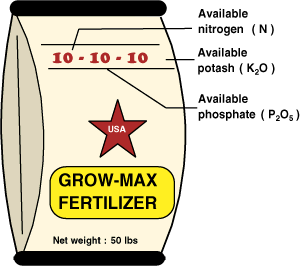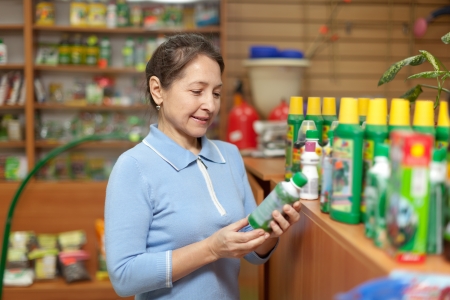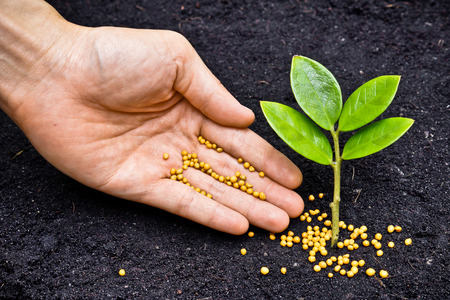As we anticipate the arrival of spring, this magnificent season brings with it a list of outdoor resolutions. Many of these promises have to do with lawn and garden projects that require a basic knowledge of fertilization. We use fertilizers in a variety of capacities: flower containers, vegetable gardens, newly planted ornamentals, and to enhance the lawn are just a few examples.
SOIL NUTRIENTS THAT PLANTS NEED TO GROW
 To make plants grow faster and healthier, we must supply the elements that the plants need in readily available forms. That is the goal of fertilizer. Whenever you see a fertilizer product, it will have three numbers prominently listed on the package, usually on the front. These numbers are very important and tell a great deal about what this fertilizer will do.
To make plants grow faster and healthier, we must supply the elements that the plants need in readily available forms. That is the goal of fertilizer. Whenever you see a fertilizer product, it will have three numbers prominently listed on the package, usually on the front. These numbers are very important and tell a great deal about what this fertilizer will do.
Nitrogen, Phosphorus, and Potassium (N,P,K) are what the numbers refer to. They are always listed in this order. It is the percentage within that package of each component. Most fertilizers provide just Nitrogen, Phosphorus and Potassium because the other chemicals are needed in much lower quantities and are generally available in most soils. Nitrogen, Phosphorus and Potassium are macronutrients whose availability is the limiting factor for growth.
For example, a common type of all-purpose fertilizer is referred to as 10-10-10. This is a balanced blend of equal portions of Nitrogen, Phosphorus, and Potassium. If you purchased a 50-pound bag, five pounds (or 10%) would be Nitrogen, five pounds would be Phosphorus, and five pounds would be Potassium. The remaining 70% is simply filler, or inert ingredients, which are there mostly to help disperse the chemicals.
UP, DOWN, ALL AROUND
This simple phrase, “Up, Down, All Around”, is an easy way to remember the primary nutrients your plants require to achieve successful growth:
Nitrogen for vegetative growth like plant leaves or grass (Up).
Phosphorus for root development (Down).
Potassium for everything (All Around).

Nitrogen (N), the first chemical listed, helps with plant growth above ground. Nitrogen does a great job of promoting the green leafy growth of foliage, and provides the necessary ingredients to produce lush green lawns. Lawn fertilizers will frequently have a high first number for this purpose.
Phosphorus (P), the middle number, is very effective at establishing growth below ground, in the form of healthy root systems. It is also the component most responsible for flower blooms and fruit production. You’ll notice that fertilizers designed for flower production, or starter-type fertilizers for your lawn, have a high middle number.
Potassium (K), the last number listed, is considered important for overall plant health. This is primarily due to its ability to help build strong cells within the plant tissue. In turn, the plants withstand various stresses, such as heat, cold, pests, and diseases. For example, winterizer fertilizers will have a high component of potassium.
When shopping for fertilizers, be mindful of their intended use. For promoting good fruit or flower production, look for a middle number that is higher than the first. Otherwise, your plants will be stimulated to put out lots of nice green foliage, likely at the expense of fruit or flower production. Instead, you want the energy and nutrition of the plant to go towards the desired result, flowers or fruit, so a higher middle number is a more appropriate choice.
To toughen up your plants or lawn for environmental stresses, then you’ll want a fertilizer that promotes the last number, and middle number. A high first number in this case may not be appropriate, because you are not likely to be promoting new lush foliage when at the same time putting plants or turf to bed for the winter. Instead, your goal should be to promote cell structure and strong roots which continue to grow through winter.

Finally, whenever you apply fertilizers, don’t assume that more is better. You can burn plants by over fertilizing, and damage the surrounding soil as well. Instead, opt for the practice of less is better.
When in doubt, hire a professional. Morrison Lawn & Landscape is a full service lawn care and landscaping company. We have served the Gastonia, NC community for 17 years. We hold a certification to apply ornamental and turf chemical products from the North Carolina Department of Agriculture and Consumer Services; likewise we maintain general liability insurance for the business. If you have interest for us to visit your Gastonia, NC property for a free consultation for weekly lawn care maintenance, contact us today at (704) 813-2545. Click here to contact us via email
